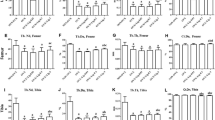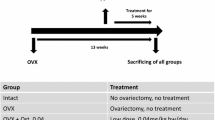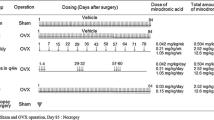Abstract
Stanozonol (ST) is a synthetic derivative of testosterone; it has anabolic/androgenic activity, increasing both the turnover of trabecular bone and the endocortical apposition of bone. The present study aimed to examine the effects of ST on bone status in rats by bone mineral content, markers of formation and resorption, bone density, and structural and microarchitectural parameters. Twenty male Wistar rats were randomly distributed into two experimental groups corresponding to placebo or ST administration, which consisted of weekly intramuscular injections of 10 mg/kg body weight of ST. Plasma parameters were analyzed by immunoassay. Bone mineral content was determined by spectrophotometry. Bone mineral density (BMD) and structural parameters were measured by peripheral quantitative computed tomography, and trabecular and cortical microarchitecture by micro-computed tomography. Plasma Ca, Mg, and alkaline phosphatase were higher, and urinary Ca excretion, corticosterone, and testosterone concentrations lower in the ST group. Femur Ca content was higher and P content was lower in the ST, whereas osteocalcin, aminoterminal propeptides of type I procollagen, and C-terminal telopeptides of type I collagen were lower. Total cross-sectional, trabecular, and cortical/subcortical areas were lower in the ST. No differences were observed on BMD and area parameters of the diaphysis as well as on trabecular and cortical microarchitecture. The use of ST increases bone mineralization, ash percentage, and Ca and Mg content in femur. In spite of an absence of changes in BMD, geometric metaphyseal changes were observed. We conclude that ST alters bone geometry, leads to low bone turnover, and thus may impair bone quality.



Similar content being viewed by others
References
Melchert RB, Welder AA (1995) Cardiovascular effects of androgenic-anabolic steroids. Med Sci Sports Exerc 27:1252–1262
Wiren KM (2008) Androgens receptor expression and steroid action in bone. In: Bilezikian JP, Raisz LG, Martin TJ (eds) Principles of Bone Biology. Springer, Berlin, pp 1001–1018
Jones MEE, Boon WC, McInnes K et al (2007) Recognizing rare disorders: aromatase deficiency. Nat Clin Pract Endocrinol Metab 3:414–421. doi:10.1038/ncpendmet0477
Hartgens F, Kuipers H (2004) Effects of androgenic-anabolic steroids in athletes. Sports Med Auckl N Z 34:513–554
Kasperk CH, Wergedal JE, Farley JR et al (1989) Androgens directly stimulate proliferation of bone cells in vitro. Endocrinology 124:1576–1578. doi:10.1210/endo-124-3-1576
Francis RM (1999) The effects of testosterone on osteoporosis in men. Clin Endocrinol 50:411–414
Cardozo CP, Qin W, Peng Y et al (2010) Nandrolone slows hindlimb bone loss in a rat model of bone loss due to denervation. Ann N Y Acad Sci 1192:303–306. doi:10.1111/j.1749-6632.2009.05313.x
Pineiro V, Casabiell X, Peino R et al (1999) Dihydrotestosterone, stanozolol, androstenedione and dehydroepiandrosterone sulphate inhibit leptin secretion in female but not in male samples of omental adipose tissue in vitro: lack of effect of testosterone. J Endocrinol 160:425–432
Spadari A, Romagnoli N, Predieri PG et al (2013) Effects of intraarticular treatment with stanozolol on synovial membrane and cartilage in an ovine model of osteoarthritis. Res Vet Sci 94:379–387. doi:10.1016/j.rvsc.2012.11.020
Fernandez L, Chirino R, Boada LD et al (1994) Stanozolol and danazol, unlike natural androgens, interact with the low affinity glucocorticoid-binding sites from male rat liver microsomes. Endocrinology 134:1401–1408. doi:10.1210/endo.134.3.8119180
Beneton MN, Yates AJ, Rogers S et al (1991) Stanozolol stimulates remodelling of trabecular bone and net formation of bone at the endocortical surface. Clin Sci Lond Engl 81:543–549
Chesnut CH 3rd, Ivey JL, Gruber HE et al (1983) Stanozolol in postmenopausal osteoporosis: therapeutic efficacy and possible mechanisms of action. Metabolism 32:571–580
Jilka RL (2013) The relevance of mouse models for investigating age-related bone loss in humans. J Gerontol A Biol Sci Med Sci 68:1209–1217. doi:10.1093/gerona/glt046
Amanzadeh J, Gitomer WL, Zerwekh JE et al (2003) Effect of high protein diet on stone-forming propensity and bone loss in rats. Kidney Int 64:2142–2149. doi:10.1046/j.1523-1755.2003.00309.x
Reeves PG, Nielsen FH, Fahey GCJ (1993) AIN-93 purified diets for laboratory rodents: final report of the American Institute of Nutrition ad hoc writing committee on the reformulation of the. J Nutr 123:1939–1951
Bekkevold CM, Robertson KL, Reinhard MK et al (2013) Dehydration parameters and standards for laboratory mice. J Am Assoc Lab Anim Sci JAALAS 52:233–239
European Union Council (2010) Directional on the Protection of Animals used for Scientific Purposes. Off J Eur Union 276:33–79
Nordstrom A, Hogstrom G, Eriksson A et al (2012) Higher muscle mass but lower gynoid fat mass in athletes using anabolic androgenic steroids. J Strength Cond Res Natl Strength Cond Assoc 26:246–250. doi:10.1519/JSC.0b013e318218daf0
Chen PS, Toribara TY, Warner H (1956) Microdetermination of Phosphorus. Anal Chem 28:1756–1758. doi:10.1021/ac60119a033
Kaija H, Jia J, Lindqvist Y et al (1999) Tartrate-resistant bone acid phosphatase: large-scale production and purification of the recombinant enzyme, characterization, and crystallization. J Bone Miner Res 14(3):421–430
Schneider MR, Mayer-Roenne B, Dahlhoff M et al (2009) High Cortical Bone Mass Phenotype in Betacellulin Transgenic Mice Is EGFR Dependent. J Bone Miner Res 24:455–467. doi:10.1359/jbmr.081202
Gentry RT, Wade GN (1976) Androgenic control of food intake and body weight in male rats. J Comp Physiol Psychol 90(1):18
Wesson DW, McGinnis MY (2006) Stacking anabolic androgenic steroids (AAS) during puberty in rats: a neuroendocrine and behavioral assessment. Pharmacol Biochem Behav 83:410–419. doi:10.1016/j.pbb.2006.03.001
Evans NA (2004) Current concepts in anabolic-androgenic steroids. Am J Sports Med 32:534–542
Liu S-Z, Yan H, Xu P et al (2009) Correlation analysis between bone mineral density and serum element contents of postmenopausal women in Xi’an urban area. Biol Trace Elem Res 131:205–214. doi:10.1007/s12011-009-8363-4
de Jong JJA, Willems PC, Arts JJ et al (2014) Assessment of the healing process in distal radius fractures by high resolution peripheral quantitative computed tomography. Bone. doi:10.1016/j.bone.2014.03.043
Liu XS, Cohen A, Shane E et al (2010) Bone density, geometry, microstructure, and stiffness: relationships between peripheral and central skeletal sites assessed by DXA, HR-pQCT, and cQCT in premenopausal women. J Bone Miner Res Off J Am Soc Bone Miner Res 25:2229–2238. doi:10.1002/jbmr.111
Liu XS, Zhang XH, Sekhon KK et al (2010) High-resolution peripheral quantitative computed tomography can assess microstructural and mechanical properties of human distal tibial bone. J Bone Miner Res Off J Am Soc Bone Miner Res 25:746–756. doi:10.1359/jbmr.090822
Liao J, Wu T, Li Q et al (2003) Effects of stanozolol on bone mineral density and bone biomechanical properties of osteoporotic rats. Di 1 Jun Yi Xue Xue Bao Acad J First Med Coll PLA 23:1117–1120
Nuti R, Righi GA, Turchetti V, Vattimo A (1984) Effects of nandrolone decanoate on bone mineral content and intestinal absorption of calcium. Min Med 75:109–113
Vanderschueren D, Venken K, Ophoff J et al (2006) Clinical review: sex steroids and the periosteum—reconsidering the roles of androgens and estrogens in periosteal expansion. J Clin Endocrinol Metab 91:378–382. doi:10.1210/jc.2005-1766
Schot LP, Schuurs AH, Kloosterboer HJ (1993) The action of anabolic steroids on bone in experimental animals. Wien Med Wochenschr 143:385–387
Li X, Takahashi M, Kushida K et al (2000) The effects of nandrolone decanoate on bone mass and metabolism in ovariectomized rats with osteopenia. J Bone Miner Metab 18:258–263
Omelon S, Georgiou J, Henneman ZJ et al (2009) Control of vertebrate skeletal mineralization by polyphosphates. PLoS One. doi:10.1371/journal.pone.0005634
Vaishnav R, Beresford JN, Gallagher JA, Russell RG (1988) Effects of the anabolic steroid stanozolol on cells derived from human bone. Clin Sci Lond Engl 74:455–460
Aerssens J, Van Audekercke R, Geusens P et al (1993) Mechanical properties, bone mineral content, and bone composition (collagen, osteocalcin, IGF-I) of the rat femur: influence of ovariectomy and nandrolone decanoate (anabolic steroid) treatment. Calcif Tissue Int 53:269–277
Jerome CP, Power RA, Obasanjo IO et al (1997) The androgenic anabolic steroid nandrolone decanoate prevents osteopenia and inhibits bone turnover in ovariectomized cynomolgus monkeys. Bone 20:355–364
Baron R, Tross R, Vignery A (1984) Evidence of sequential remodeling in rat trabecular bone: morphology, dynamic histomorphometry, and changes during skeletal maturation. Anat Rec 208:137–145. doi:10.1002/ar.1092080114
Sengupta P (2013) The laboratory rat: relating its age with human’s. Int J Prev Med 4:624–630
Tauer JT, Hofbauer LC, Jung R et al (2015) Impact of long-term exposure to the tyrosine kinase inhibitor imatinib on the skeleton of growing rats. PLoS One 10:e0131192. doi:10.1371/journal.pone.0131192
Huang RY, Miller LM, Carlson CS, Chance MR (2002) Characterization of bone mineral composition in the proximal tibia of cynomolgus monkeys: effect of ovariectomy and nandrolone decanoate treatment. Bone 30:492–497
Burnell JM, Baylink DJ, Chestnut CH 3rd et al (1982) Bone matrix and mineral abnormalities in postmenopausal osteoporosis. Metabolism 31:1113–1120
Dohle GR, Smit M, Weber RFA (2003) Androgens and male fertility. World J Urol 21:341–345. doi:10.1007/s00345-003-0365-9
Sturmi JE, Diorio DJ (1998) Anabolic agents. Clin Sports Med 17:261–282
Spitz IM, Margalioth EJ, Yeger Y et al (1984) Effect of non aromatizable androgens on LHRH and TRH responses in primary testicular failure. Horm Metab Res Horm Stoffwechselforschung Horm Metab 16:492–497. doi:10.1055/s-2007-1014827
Schlussman SD, Zhou Y, Johansson P et al (2000) Effects of the androgenic anabolic steroid, nandrolone decanoate, on adrenocorticotropin hormone, corticosterone and proopiomelanocortin, corticotropin releasing factor (CRF) and CRF receptor1 mRNA levels in the hypothalamus, pituitary and amygdala of the rat. Neurosci Lett 284:190–194
Alsio J, Birgner C, Bjorkblom L et al (2009) Impact of nandrolone decanoate on gene expression in endocrine systems related to the adverse effects of anabolic androgenic steroids. Basic Clin Pharmacol Toxicol 105:307–314. doi:10.1111/j.1742-7843.2009.00439.x
Frenkel B, White W, Tuckermann J (2015) Glucocorticoid-Induced Osteoporosis. Adv Exp Med Biol 872:179–215. doi:10.1007/978-1-4939-2895-8_8
Cannata-Andia JB, Rodriguez Garcia M, Gomez Alonso C (2013) Osteoporosis and adynamic bone in chronic kidney disease. J Nephrol 26:73–80. doi:10.5301/jn.5000212
Funding
This study was supported by the project DEP2008-04376 from the Ministry of Science and Innovation and Grants from the Spanish Ministry of Education (AP2009-5033, AP2009-3173). VAA was supported by the Andalucía Talent Hub Program launched by the Andalusian Knowledge Agency, co-funded by the European Union’s Seventh Framework Program, Marie Skłodowska-Curie actions (COFUND–Grant Agreement no. 291780) and the Ministry of Economy, Innovation, Science and Employment of the Junta de Andalucía.
Authors’ Contributions
EN was involved organizing this research, the acquisition of data, analysis and interpretation of data, and drafting the manuscript. She is guarantor. VAA was involved in the conception, planning, and designing this study, and the acquisition, analysis, and interpretation of data. DC was involved in the acquisition of data. RM was involved in the acquisition of data. RGE was involved in the analysis and interpretation of data. GK was involved in the acquisition of data. CS was involved in the analysis and interpretation of data. CT was involved in planning and designing this study. JMP was involved in the analysis, the acquisition and interpretation of data, and revising the manuscript. MLJ was involved in the conception, planning, and designing this study, and drafting and revising the manuscript. PA was involved in the conception, planning, and designing this study, and the acquisition, analysis, and interpretation of data. PP was involved in the analysis and interpretation of the data and revising the manuscript. All authors revised the paper critically for intellectual content and approved the final version. All authors agree to be accountable for the work and to ensure that any questions relating to the accuracy and integrity of the paper are investigated and properly resolved.
Author information
Authors and Affiliations
Corresponding author
Ethics declarations
Conflict of Interest
E. Nebot, V. A. Aparicio, D. Camiletti-Moirón, R. Martinez, R. G. Erben, G. Kapravelou, C. Sánchez-González, C. De Teresa, J. M. Porres, M. López-Jurado, P. Aranda, P. Pietschmann declare that they have no conflict of interest.
Human and Animal Rights and Informed Consent
All procedures performed in studies involving animals were in accordance with the ethical standards of the institution or practice at which the studies were conducted.
Rights and permissions
About this article
Cite this article
Nebot, E., Aparicio, V.A., Camiletti-Moirón, D. et al. Stanozolol Decreases Bone Turnover Markers, Increases Mineralization, and Alters Femoral Geometry in Male Rats. Calcif Tissue Int 98, 609–618 (2016). https://doi.org/10.1007/s00223-016-0108-8
Received:
Accepted:
Published:
Issue Date:
DOI: https://doi.org/10.1007/s00223-016-0108-8




